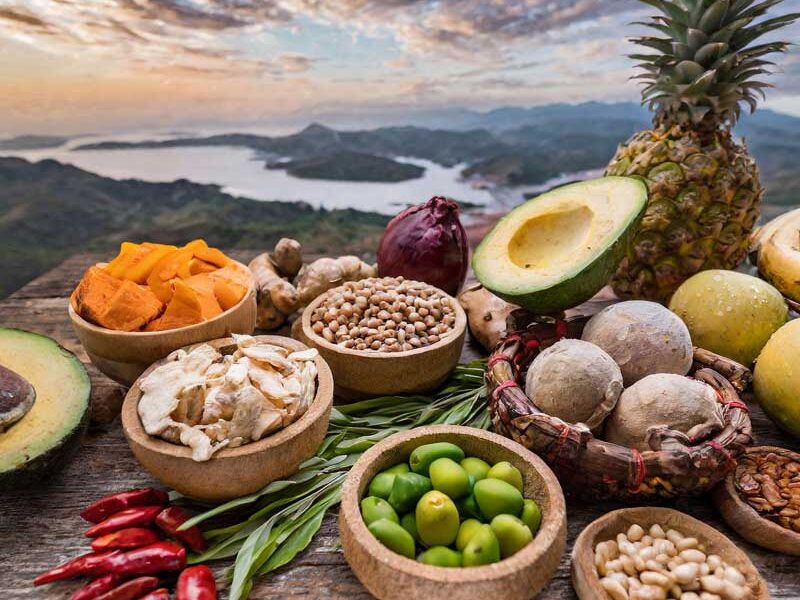Introduction
Welcome to How to Incorporate Indigenous Foods into Modern Diets and the culinary adventure of a lifetime, where the past meets the present, and your taste buds get a history lesson. This isn’t just another diet trend; it’s a revival, a renaissance, and frankly, the best thing since sliced bread was deemed boring. Let’s dive into how you can incorporate indigenous foods into your modern diet, adding flavor, nutrition, and a sprinkle of humor to your daily meals.
The Relevance of Indigenous Foods Today
In a world where fast food reigns supreme and mystery ingredients lurk in every processed meal, turning to indigenous foods is like hitting the dietary jackpot. These are the foods that have sustained civilizations for centuries, and guess what? They didn’t need a 20-ingredient label to do so. It’s time to strip back to the basics and rediscover the wealth of nutrition and flavor that indigenous foods offer.
Identifying Indigenous Foods
First things first, let’s identify what we mean by “indigenous foods.” These are foods that were consumed by the local population of a region before the arrival of European colonizers. Think quinoa from the Andes, amaranth from Mexico, or the myriad of fruits and vegetables from the Amazon. If it was good enough for your great-great-great-grandparents, it’s good enough for you.
Benefits of Indigenous Foods
Indigenous foods are not just good for the ‘gram; they pack a nutritional punch that could knock out your average processed snack. Rich in vitamins, minerals, and antioxidants, these foods offer a range of health benefits, from improved digestion to a lower risk of chronic diseases. Plus, they come with the added bonus of sustainability and supporting local communities.
Integrating Indigenous Foods into Your Diet

Now, for the fun part. Incorporating indigenous foods into your diet doesn’t mean you need to dine by candlelight and forage for your meals (unless you’re into that sort of thing). Here are some simple ways to get started:
- Swap Out Staples: Replace rice with quinoa or try using coconut oil instead of your usual vegetable oil.
- Snack Smart: Ditch the chips for roasted nuts and seeds, like chia or pumpkin seeds.
- Go Green: Experiment with leafy greens like moringa or kale in your smoothies and salads.
Fun and Unconventional Ways to Enjoy Indigenous Foods
Who said eating healthy had to be boring? Here are some unexpected and slightly humorous ways to enjoy indigenous foods:
- The Quinoa Quiche: Who needs a crust when you can have a protein-packed quinoa base?
- Amaranth Avenger: Create a superhero-themed breakfast with amaranth porridge. Bonus points if you wear a cape while eating it.
- Wild Berry Bingo: Make trying new indigenous berries a game. Can’t find them at your local store? Foraging for them (safely) can be an adventure in itself.
The Challenges of Incorporating Indigenous Foods
Let’s not sugarcoat it (mainly because we’re talking about healthy eating) – incorporating indigenous foods into your diet can have its challenges. Availability, cost, and unfamiliarity can be hurdles, but with a bit of creativity and flexibility, you can overcome them. Remember, every small change adds up.
FAQs
Q: Can indigenous foods really make a difference in my diet? A: Absolutely! Besides their nutritional benefits, they add variety and can help reduce the environmental impact of your diet.
Q: Aren’t indigenous foods more expensive? A: While some may be pricier due to their “superfood” status, many are actually more affordable and sustainable options in the long run.
Q: How can I find indigenous foods in my area? A: Start at local farmers’ markets, health food stores, or specialty shops. You can also join community gardens or food co-ops that focus on local and sustainable produce.
Conclusion
Incorporating indigenous foods into your modern diet is like adding a dash of adventure to every meal. It’s a journey back in time that doesn’t require a time machine, just a curious palate and a willingness to explore. So, let’s embrace the wisdom of our ancestors, one delicious bite at a time, and transform our meals into a celebration of history, culture, and health.
Please follow us on linkedin. You can learn all best canadian food recipes you can check our Culinary 1TouchFood Youtube and Telegram 1TouchFood page. Don’t forget Fighting Obesity Magazine and Radio Cooking.

